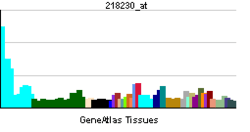ARFIP1
Arfaptin-1 is a protein that in humans is encoded by the ARFIP1 gene.[3][4][5]
Interactions
ARFIP1 has been shown to interact with ARF3.[3][4]
References
Further reading
- Tsai SC, Adamik R, Hong JX, et al. (1998). "Effects of arfaptin 1 on guanine nucleotide-dependent activation of phospholipase D and cholera toxin by ADP-ribosylation factor". J. Biol. Chem. 273 (33): 20697–701. doi:10.1074/jbc.273.33.20697. PMID 9694811.
- Suzuki Y, Tsunoda T, Sese J, et al. (2001). "Identification and characterization of the potential promoter regions of 1031 kinds of human genes". Genome Res. 11 (5): 677–84. doi:10.1101/gr.164001. PMC 311086
 . PMID 11337467.
. PMID 11337467.
- Strausberg RL, Feingold EA, Grouse LH, et al. (2003). "Generation and initial analysis of more than 15,000 full-length human and mouse cDNA sequences". Proc. Natl. Acad. Sci. U.S.A. 99 (26): 16899–903. doi:10.1073/pnas.242603899. PMC 139241
 . PMID 12477932.
. PMID 12477932.
- Ho WT, Exton JH, Williger BT (2003). "Arfaptin 1 inhibits ADP-ribosylation factor-dependent matrix metalloproteinase-9 secretion induced by phorbol ester in HT 1080 fibrosarcoma cells". FEBS Lett. 537 (1–3): 91–5. doi:10.1016/S0014-5793(03)00098-X. PMID 12606037.
- Ota T, Suzuki Y, Nishikawa T, et al. (2004). "Complete sequencing and characterization of 21,243 full-length human cDNAs". Nat. Genet. 36 (1): 40–5. doi:10.1038/ng1285. PMID 14702039.
- Brandenberger R, Wei H, Zhang S, et al. (2005). "Transcriptome characterization elucidates signaling networks that control human ES cell growth and differentiation". Nat. Biotechnol. 22 (6): 707–16. doi:10.1038/nbt971. PMID 15146197.
- Gerhard DS, Wagner L, Feingold EA, et al. (2004). "The status, quality, and expansion of the NIH full-length cDNA project: the Mammalian Gene Collection (MGC)". Genome Res. 14 (10B): 2121–7. doi:10.1101/gr.2596504. PMC 528928
 . PMID 15489334.
. PMID 15489334.
- Foster LJ, Rudich A, Talior I, et al. (2006). "Insulin-dependent interactions of proteins with GLUT4 revealed through stable isotope labeling by amino acids in cell culture (SILAC)". J. Proteome Res. 5 (1): 64–75. doi:10.1021/pr0502626. PMID 16396496.


 . PMID 11337467.
. PMID 11337467. . PMID 12477932.
. PMID 12477932. . PMID 15489334.
. PMID 15489334.